Intel Celeron 847 for Atom: MSI C847IS-P33 Mainboard Review

By combining their energy-efficient Celeron 847 processor with an NM70 chipset Intel created a new desktop platform for SFF PC, which may easily push Atom and Brazos of the pedestal. Our today’s test session will show if the new product with Core microarchitecture is capable of competing against specialty energy-efficient and inexpensive processors.
The 2009 release of Intel’s Atom processors was a revolutionary event on the market of x86 computers. Not very fast but highly economical, those CPUs proved that there existed a huge range of applications for which sheer speed was not the top priority. The Atom gave rise to a whole new class of devices, namely netbooks and nettops which featured small size, low weight, low power consumption, and attractive price. Computers of that kind were quick to win the customer’s heart and rose to huge popularity in just a few years. Thus, the Atom was an unquestionable success as a concept.
Meanwhile, the further development of that concept showed Intel’s conservative side. People loved the economical Atom but its integrated graphics core was not up to the mark, especially as it lacked hardware acceleration for HD video, limiting the Atom’s applications in home and multimedia PCs. As a result, users were prone to prefer configurations that solved the problem of poor graphics performance in some way. For example, Nvidia’s ION platform got some recognition at first as it replaced Intel’s integrated graphics core with Nvidia’s own which featured a video decoder and provided higher 3D graphics performance. However, Intel didn’t seem to take any notice of the high sales of alternative Atom-based platforms and later forced third-party chipset makers to give up using their system bus through a court decision.
So the lucrative market of inexpensive HTPCs was lost for the Intel Atom platform while AMD seized the opportunity by offering its alternative codenamed Brazos. Although AMD’s solution wasn’t any faster than the Atom in sheer computing, it did sport a much better graphics core with a hardware HD video decoder and high 3D graphics performance. Besides occupying the niche of inexpensive compact multimedia computers, the Brazos platform was competitive in the Atom’s traditional habitat, becoming in fact one of the most successful of AMD’s recent projects. There were fewer Atom-based nettops and netbooks because they were replaced with products based on AMD’s E series processors.
In early 2012 Intel tried to make the Atom more attractive by replacing its graphics core. The company put its stake on the PowerVR solution which could accelerate HD video playback in various formats. It was ill-fated, though. First of all, Intel never managed to release a problem-free 64-bit driver for it. And second, the new graphics core proved to be unexpectedly slow with the ordinary 2D interface of the operating system. That’s why Atom CPUs are but seldom viewed as an option for compact nettops today. Talking about the Atom’s current role, Intel focuses on mobile gadgets (for which the Atom is reincarnated as a SoC solution) or micro-servers.
When it comes to desktop applications, Intel suggests a completely different approach, offering adapted CPUs with Core microarchitecture: mobile ULV processors in FCBGA packaging. The Celeron 847 is one of the popular solutions of that kind, being widely used on various mini-ITX mainboards. It is a dual-core Sandy Bridge CPU with reduced clock rates and voltage. Can it make a worthy opponent to the Brazos platform and carry on the Atom’s traditions? We’ll check it out in this review by testing the MSI C847IS-P33 mainboard.
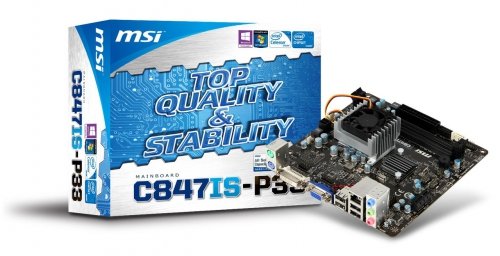
Closer look at the Platform: Intel Celeron 847 CPU + Intel NM70 Chipset
Having experimented with Atom CPUs and found no way to make them stay in compact PCs, Intel turned to Plan B which meant the promotion of CPUs with the premium Core architecture but adapted for low power consumption. Fortunately, the Core is a versatile microarchitecture that can be employed for high-performance and energy-efficient applications alike. The configuration Intel wants to suggest as an alternative to the latest Atom-based platform Cedar Trail consists of highly economical components which are initially designed for mobile solutions. Considering that low pricing has always been a key feature of Atom CPUs, such components are also very inexpensive.
So, the platform positioned by Intel as a basis for SFF PCs is based on the dual-core Celeron 847 processor (or its single-core cousin Celeron 807). There’s nothing particularly new about it as it was introduced as a mobile solution two years ago, yet it’s only recently that Intel has oriented it at nettops and mini-ITX mainboards. It is no wonder then that the Celeron 847 is manufactured on old 32nm tech process and represents the Sandy Bridge design.
The Celeron 847 has a typical TDP of 17 watts but its real heat dissipation must be lower. On the majority of mainboards it is only equipped with a small aluminum cooler with 40mm fan. The low power consumption and heat dissipation are ensured in a brute force way by lowering voltage to about 0.5 volts. The clock rate is very low under such conditions – 1.1 GHz only. We shouldn’t forget that it is a full-featured Sandy Bridge, though. It is a CPU with out-of-order execution, each of its cores capable of crunching through up to four x86 instructions per clock cycle.
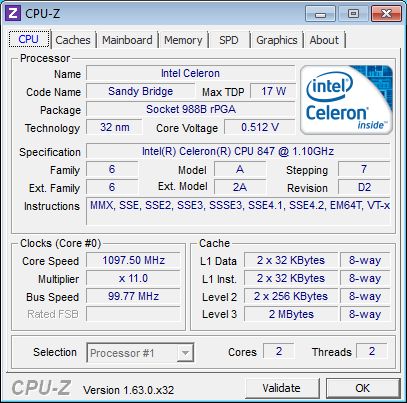
Moreover, the Celeron 847 boasts some new features compared to the Atom series including a shared 2MB L3 cache, SSE 4.2 support, and a dual-channel memory controller. The Intel HD Graphics core is fundamentally superior to the Atom’s GMA 3600. It has no problems decoding HD video, supports DirectX 10 and offers higher performance, even though its clock rate is lower than in ordinary Sandy Bridge CPUs (800 MHz in 3D mode and 350 MHz in 2D mode).
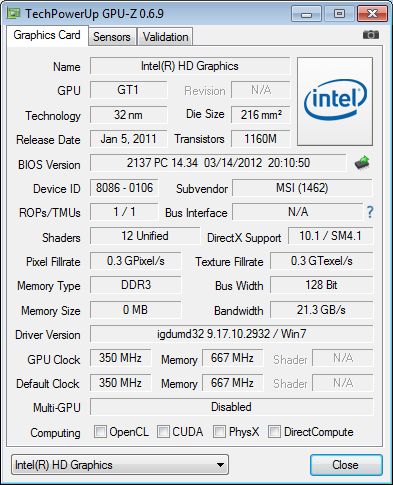
Being originally conceived as mobile solutions, Celeron 847 CPUs are manufactured as BGA1023 chips and get soldered to mainboards. As with the Atom, there’s no talking about upgrades, of course.
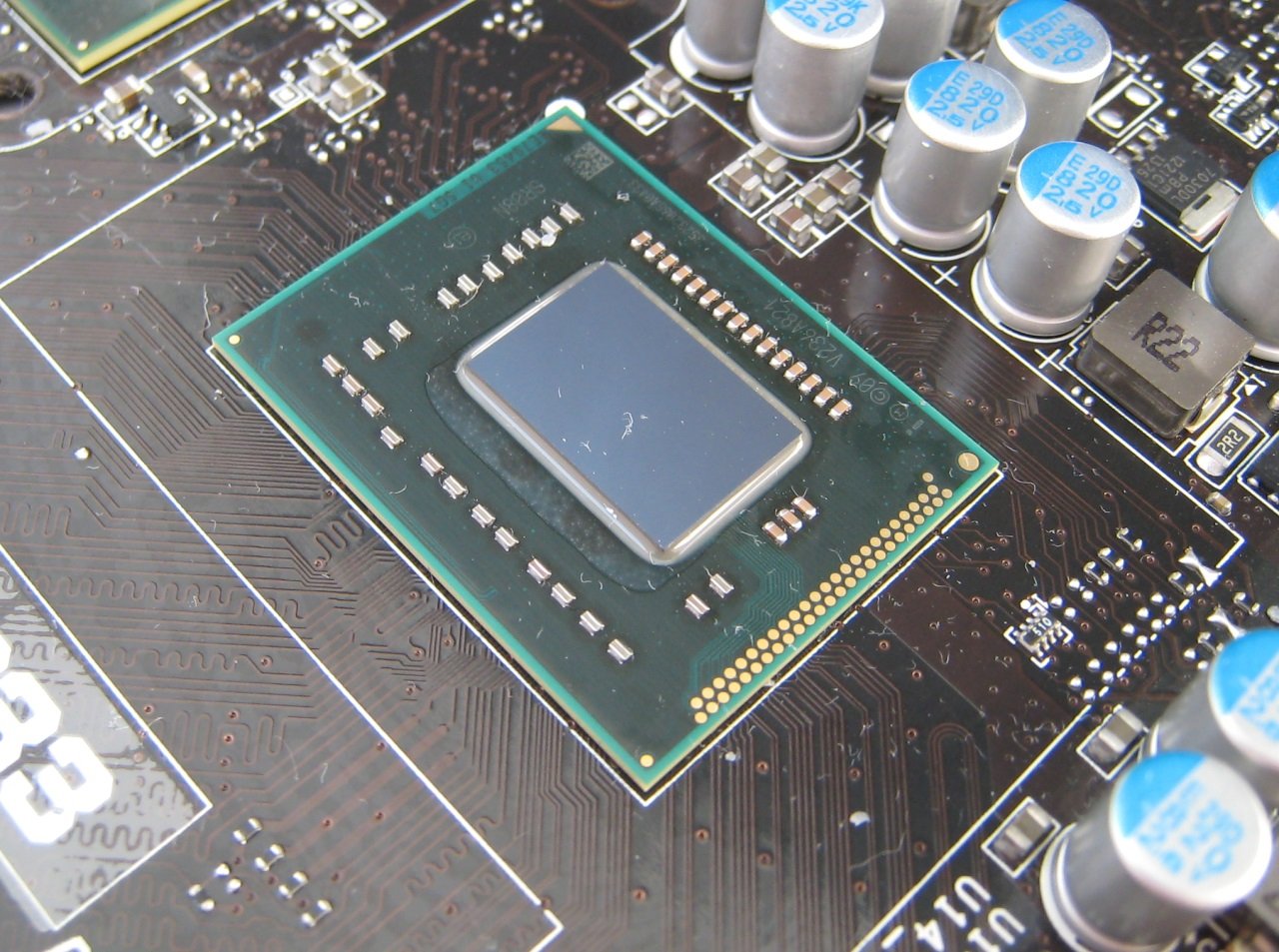
Intel’s NM70 chipset serves as the Celeron 847’s companion. It is akin to other series 7 chipsets from Intel such as the Intel Z77, but its capabilities are severely limited. The NM70 is closer to the mobile HM70 chipset in specifications and has the same specified TDP of 4.1 watts, but the number of PCI Express lanes and USB ports is reduced, which gives us the following characteristics:
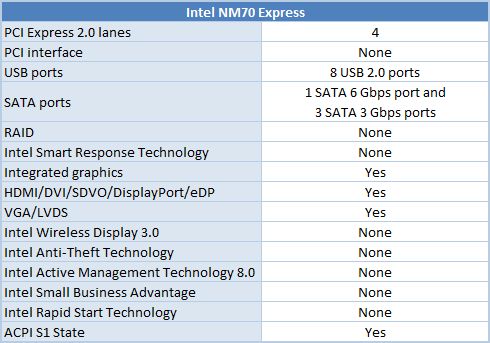
The chipset is connected with the CPU with a standard DMI 2.0 bus that has a bandwidth of 20 Gbps, making the Celeron 847 + NM70 Express pair similar to any other Sandy Bridge or Ivy Bridge platform except for the limited expansion capabilities. Particularly, they do not allow using external graphics cards and only offer four PCI Express lanes for additional controllers.
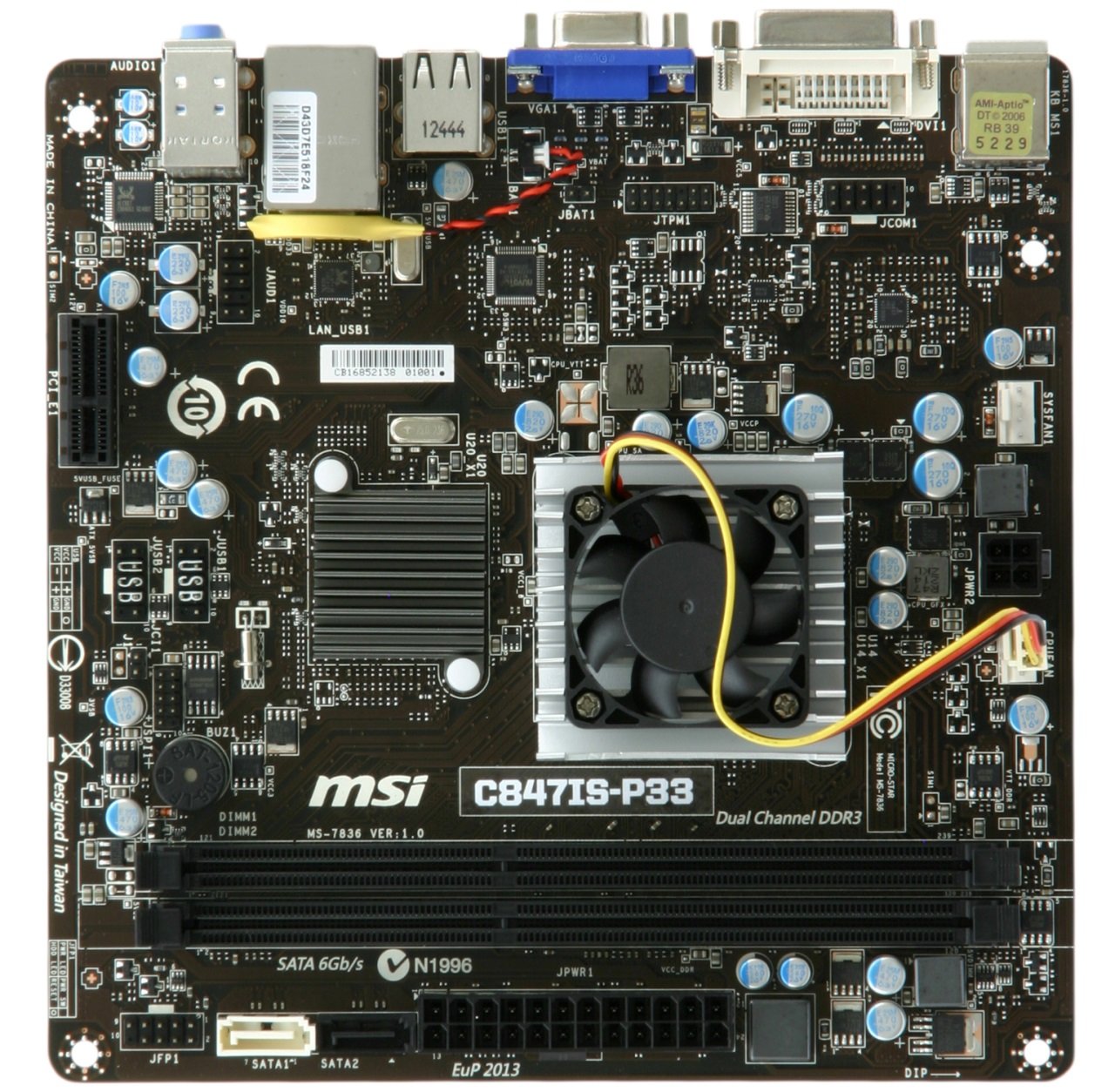
All mini-ITX mainboards have a lot of things in common. And they even look alike if they’ve got an integrated processor. Therefore the only visual difference about the MSI C847IS-P33 is its PCI Express x1 slot which is usually replaced with an ordinary PCI (in case of Atom-based mainboards) or PCI Express x16 (in case of mainboards with AMD E series processors). The integrated Celeron 847 makes the MSI mainboard different in another, even though not obvious, way. Like any Sandy Bridge, it features a dual-channel memory controller whereas the other integrated platforms only have a single-channel controller. That’s why it makes sense to fill both DDR DIMM slots of the MSI C847IS-P33 with memory sticks.
The cooling system deployed on the MSI C847IS-P33 is indicative of a rather advanced processor as the Celeron 847 carries a larger-than-usual cooler. Secured with screws, the cooler has a fan which works at a constant speed of 5600 RPM, producing an audible rattle. The speed cannot be regulated because the fan uses a 3-pin connection whereas the mainboard only supports PWM-based regulation. So, if you’re going to use the MSI C847IS-P33 in a home PC, you may want to replace its default cooler. The nearby chipset is cooled by a small heatsink with barely noticeable finning. That should be enough considering the low heat dissipation of the NM70 chip.
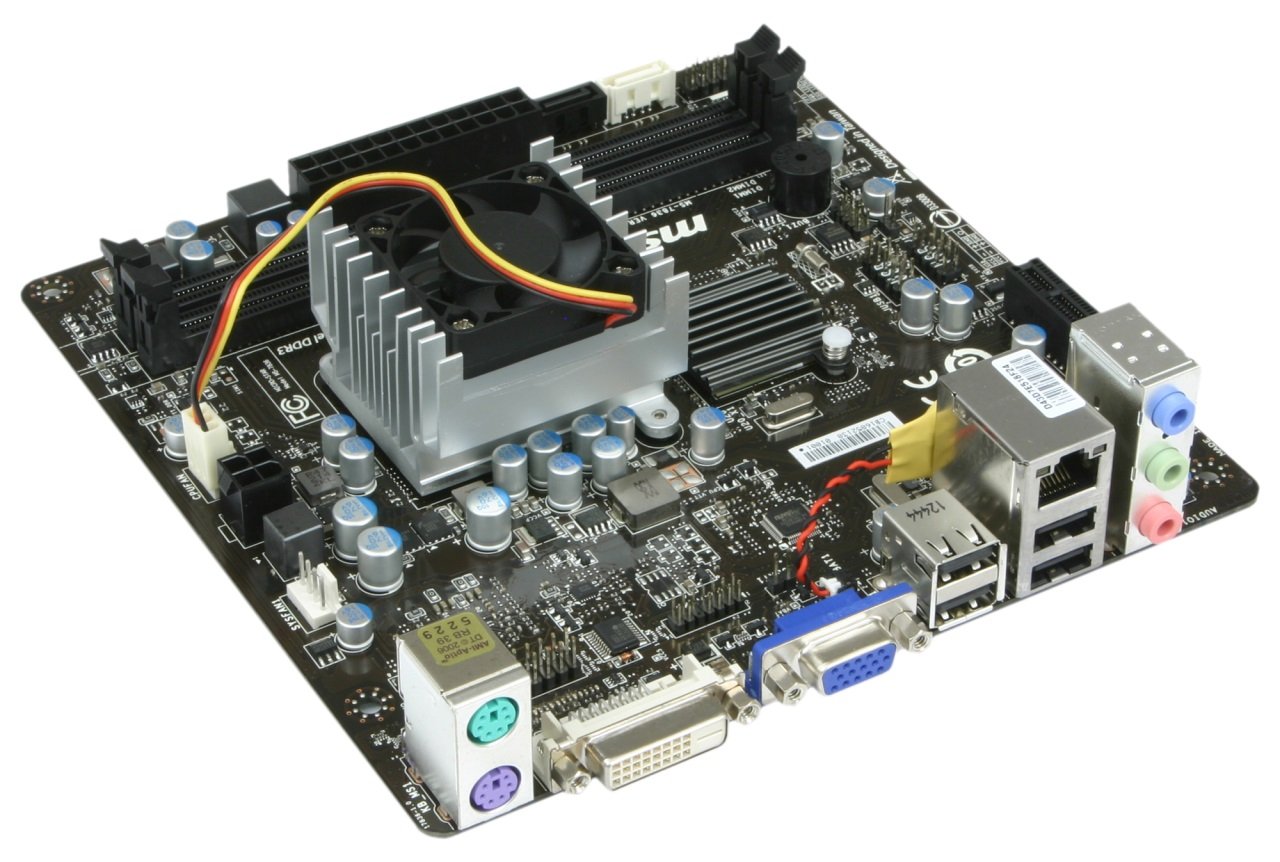
The power system of the MSI C847IS-P33 is rather primitive but there’s no point in discussing it at length. The mainboard doesn’t support CPU overclocking anyway. We can only note that you have to connect a 4-pin 12V ATX power cable to it. The mainboard wouldn’t work without that, unlike its Atom-based counterparts.
MSI intends the C847IS-P33 for small form-factor PCs in the first place, judging by the selection of its onboard headers. There are but two SATA ports and only one of them is 6 Gbit/s. There are two USB headers but the mainboard doesn’t support USB 3.0. The MSI C847IS-P33 lacks any additional controllers, owing all of its functionality to the chipset.
That’s why there are but few connectors on its back panel, too: four USB 2.0 ports, PS/2 sockets for mouse and keyboard, a Gigabit Ethernet port (it works via a Realtek RT L8111E controller), and three analog audio sockets. An eight-channel Realtek ALC887 codec is used but the shortage of audio connectors means you can only use 6-channel speaker systems. The MSI C847IS-P33 has no SPDIF output but allows connecting two monitors via an analog VGA port and a digital DVI-D.

The MSI C847IS-P33 seems to be limited in functionality but it has an attractive price. Coupled with the integrated Celeron 847, it comes at a recommended $75, which is less than you’re asked to pay for most solutions with AMD E series or Intel Atom processors.
It wouldn’t be right to criticize anything about a mainboard which is that inexpensive, yet its BIOS is just too abridged. The interface is text-based, even though with added mouse support. The number of setup options is so limited that you will hardly have any need to enter this BIOS at all. The mainboard doesn’t allow you to tweak any frequencies or voltages. You cannot control CPU technologies or correct the memory operation mode selected by the mainboard. In fact, the BIOS interface only lets you manage the integrated device controllers.
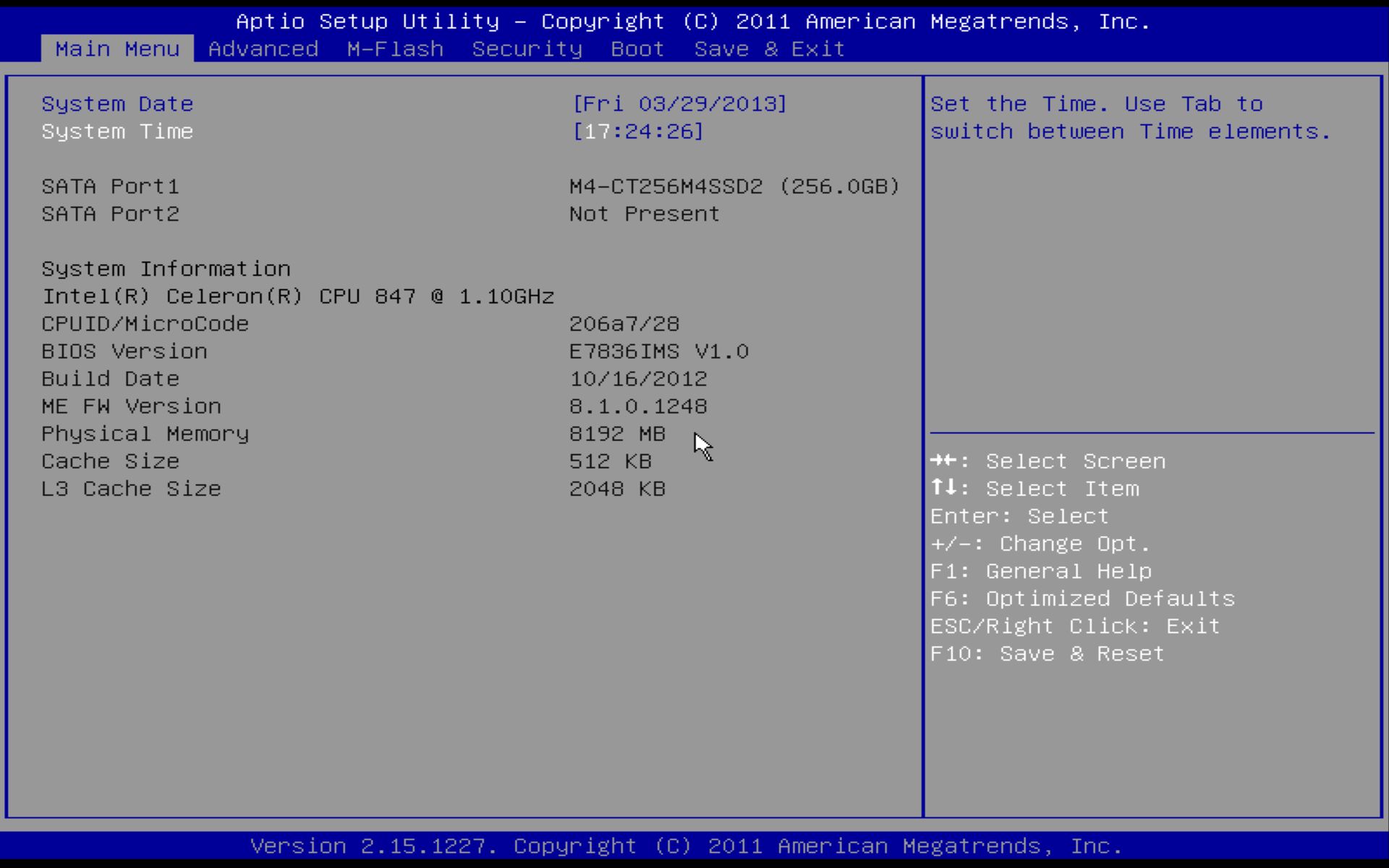
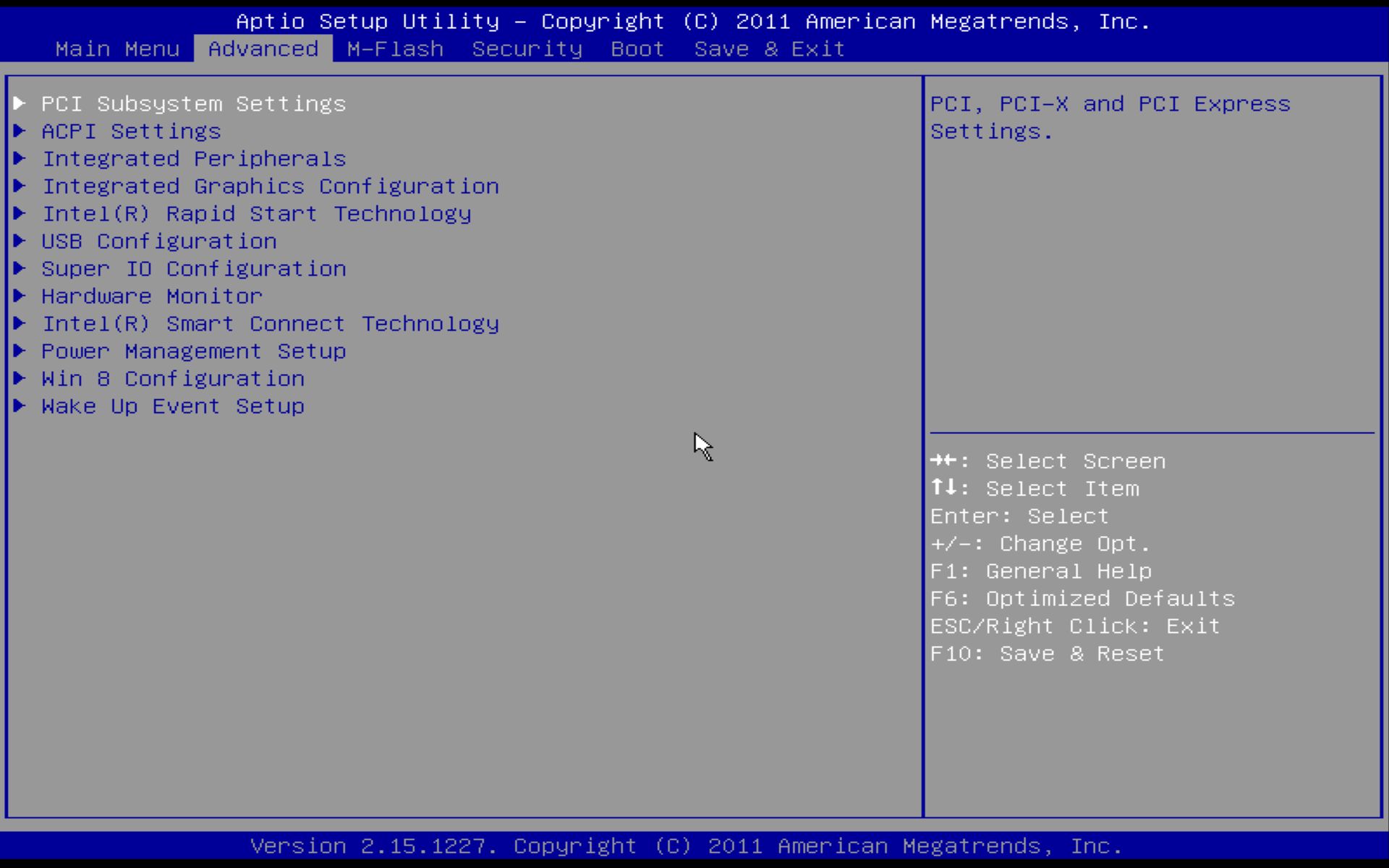
There is a hardware monitoring section, too. The mainboard reports system and CPU temperatures and supports PWM-based speed regulation for two fans. But the default fan installed on the CPU heatsink cannot be regulated since it uses a 3-pin connection.
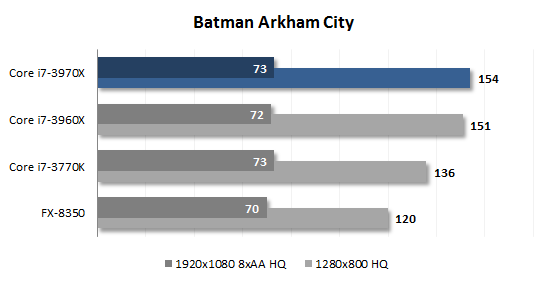
The specifications of the MSI C847IS-P33 are summarized in the following table:
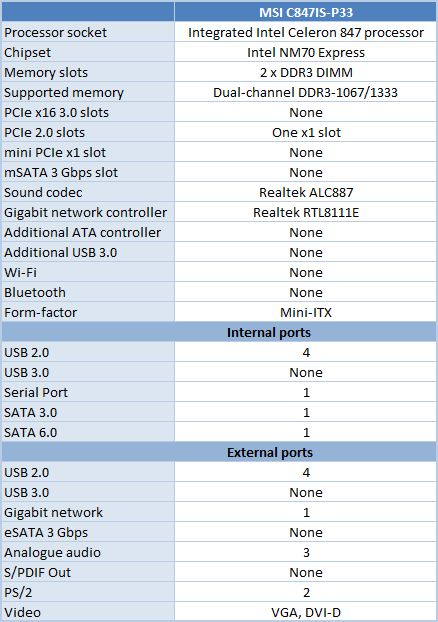
Testing Methodology
Since mini-ITX mainboards with Celeron 847 are positioned as an alternative to highly integrated solutions with built-in AMD Bobcat or Intel Atom processors, we are going to compare the MSI C847IS-P33 with such opponents in the first place.
One of them is the Intel D2700DC mainboard which features the fastest Atom available – Atom D2700. Based on the 32nm Cedarview design, it has two execution cores, 1MB L2 cache and a clock rate of 2.13 GHz. It supports Hyper-Threading and has a TDP of 10 watts.
The second mainboard is ASRock’s E350M1 with AMD E-350, a 40nm CPU with Bobcat microarchitecture which is clocked at 1.6 GHz, has two execution cores, 1MB L2 cache and a TDP of 18 watts.
The third mainboard included into this comparison is MSI’s Z77IA-E53. It is an LGA1155 mini-ITX solution with Intel Z77 chipset and we use it with a regular desktop processor Celeron G1610, the junior embodiment of the Ivy Bridge design). It will help us see how platforms with economical CPUs compare with ordinary desktop configurations.
During this test session we used the following hardware and software components:
- Mainboards and platforms:
- ASRock E350M1 (AMD E-350 + AMD Hudson M1);
- Intel Desktop Board D2700DC (Intel Atom D2700 + Intel NM10 Express);
- MSI C847IS-P33 (Intel Celeron 847 + Intel NM70 Express);
- MSI Z77IA-E53 (Intel Celeron G1610 + Intel Z77 Express).
- Memory:
- 2 x 2 GB DDR3-1333 SDRAM DIMM (Kingston KHX1600C8D3K2/4GX) 9-9-9-27;
- 2 x 2 GB DDR3-1333 SDRAM SODIMM (Apogee AS2G733-13G) 9-9-9-27.
- Hard drive: Crucial m4 256 GB (CT256M4SSD2).
- Power supply unit: Corsair AX760i (80 Plus Platinum, 760 ??).
- Operating system: Microsoft Windows 7 SP1 Home Premium x86.
- Drivers:
- AMD Catalyst 13.1 Driver;
- AMD Chipset Driver 13.1;
- Intel Chipset Driver 9.2.2.1034;
- Intel Graphics Media Accelerator Driver 8.14.8.1083;
- Intel Graphics Media Accelerator Driver 15.28.12.2932.
Although the CPUs we are about to test represent very different microarchitectures, we want to show you a table with their basic specs:
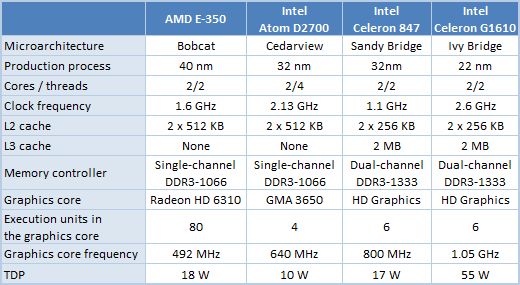
We need to make one important remark before we proceed to our testing. Although we long ago switched to 64-bit versions of Windows 7 or 8 in our reviews, we have to install a 32-bit OS in this case because the Cedarview’s integrated graphics core hasn’t yet acquired a 64-bit driver and is unlikely to do so in the future. There is even no beta version of such a driver, so the Atom-based platform may only be viewed as 32-bit, even though the Atom itself supports the 64-bit extensions.
Computing Performance
We use the newest 1.4.0 version of Futuremark PCMark 7 to check out overall performance in everyday applications using two test traces: for regular and low-performance systems.
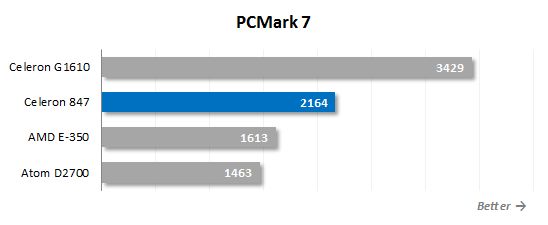
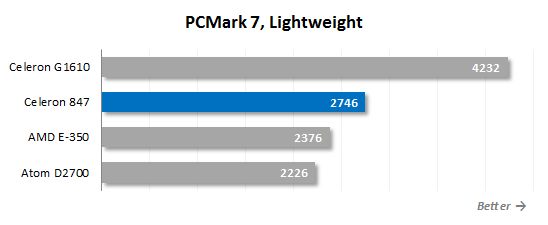
The Celeron 847 looks very good against the AMD E-350 and Intel Atom D2700. Notwithstanding its rather low clock rate of 1.1 GHz, it can deliver good performance thanks to its Core microarchitecture. However, it is slower in comparison with the ordinary desktop Celeron G1610, which might be expected considering the difference in their clock rates.
The internet performance is tested with Futuremark Peacekeeper launched on the latest, 25th version of Google Chrome.
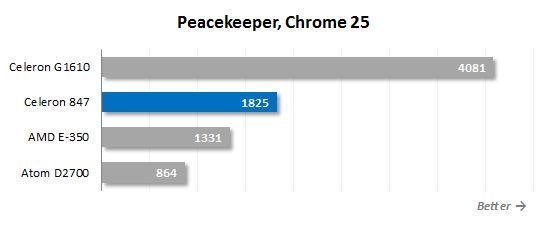
Although Google Chrome creates a separate process for each tab, these processes are single-threaded. That’s why this test is indicative of the speed of each particular CPU core. We can see that the Celeron 847 is more than twice as fast as the Atom D2700 and outperforms the AMD E-350 by almost 40%. It looks like the Celeron 847 is a good solution for nettops serving for internet access. The Celeron G1610 is much faster, of course, but it runs on a higher-class platform.
For our data compression test we use 7-zip’s LZMA2 algorithm to archive a 715MB folder with files.
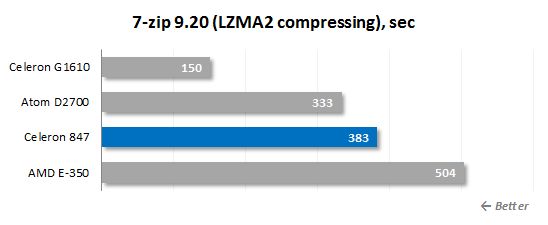
We’ve got an unusual picture here. 7-zip can run in parallel on multiple CPU cores, so the Atom D2700, which can execute up to four instruction threads concurrently thanks to Hyper-Threading, copes with this task better than both the AMD E-350 and the Celeron 847.
We benchmark performance in Adobe Photoshop CS6 using our custom test that is based on the Retouch Artists Photoshop Speed Test and consists of typical processing of four 24-megapixel images captured with a digital camera.
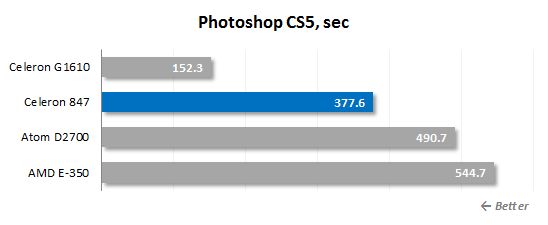
The Celeron 847 is brilliant again, delivering much higher performance in comparison with the other inexpensive and economical processors. It might be expected since processing high-resolution images depends on memory bandwidth and the Celeron, unlike the AMD E series and the Intel Atom, features a dual-channel controller with support for DDR3-1333. It must also be noted that the Celeron 847, positioned as an opponent to the Brazos platform, is barely half as fast as the junior desktop LGA1155 CPU of the Ivy Bridge family.
In the audio encoding test we measure the speed of converting a music album from FLAC into MP3 format using Xilisoft Audio Converter 6.4.
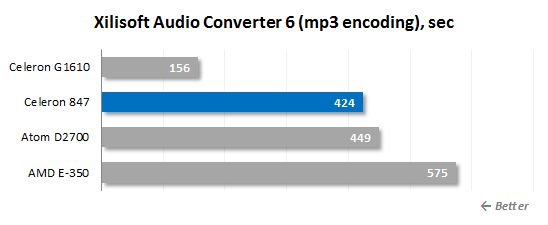
Although Xilisoft Audio Converter is optimized for multi-core CPUs, the Celeron 847 is ahead of the Atom D2700 which can perform four instruction threads concurrently. The gap isn’t large, though, at only 6%. The AMD E-350 is slower by a third in comparison with same-class Intel CPUs.
Video transcoding isn’t a typical application for Atom-based and similar systems, but we want to check it out anyway. In this test we use MediaCoder 0.8 to convert an H.264 1080p video clip into a format supported by the Apple iPad2. The speed is measured in frames per second.
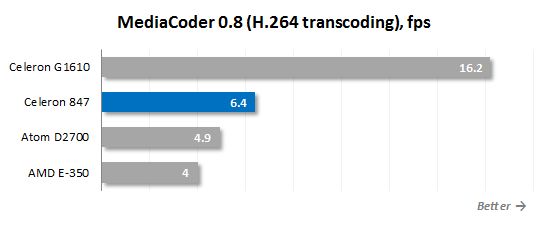
The Celeron 847 has an overwhelming advantage in this transcoding test. It is far superior to the Bobcat and Atom CPUs in terms of computing performance, yet remains a lower-class solution compared to inexpensive platforms based on Intel’s Socket LGA1155 processors.
Before testing the processors’ integrated graphics cores, we want to show you the Physics Score results of Futuremark 3DMark Cloud Gate. It is the speed of a special gaming physics test which models the behavior of a complex system consisting of numerous objects.
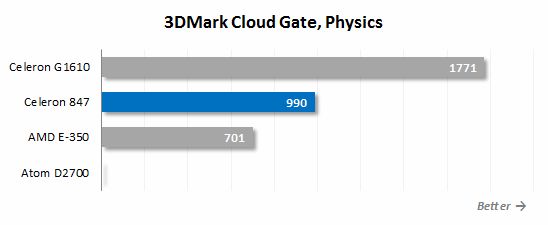
Unfortunately, the Atom D2700 can’t pass this test as it doesn’t support DirectX 10. Otherwise, the standings are just as expected: the Celeron 847 is about 40% faster than the AMD E-350 but only half as fast as its full-featured cousin.
Graphics Performance
We do not normally test 2D graphics performance in our reviews but the Cedarview-based Atoms made us change our custom because their integrated graphics core GMA 3650 was criticized for being too slow at rendering the OS interface. Driver updates have improved this situation, so opening, closing and moving application windows is fast enough now, yet we want to show this in numbers using PassMark Performance Test 8.0 which has a handy 2D graphics benchmark.
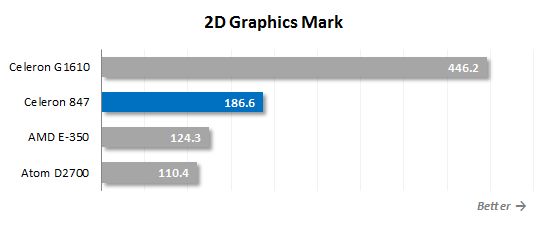
So indeed, the GMA 3650 core from the Atom D2700 has the lowest speed but the AMD E-350 isn’t much better. The Celeron 847 is ahead of both, but modern Ivy Bridge Celerons make the OS interface even more responsive. One thing must be noted specifically: the Atom D2700 is the only CPU in this review that is incompatible with Windows 7’s Aero interface. Although you can enable the latter, the rendering speed plummets down, so it becomes impossible to work even with simplest applications.
HD video playback is important for HTPCs which run on mini-ITX platforms with economical processors, so we want to check out this usage scenario, too.
Atom (Cedarview), E series (Bobcat) and Celeron (Sandy Bridge) processors all feature hardware engines for accelerated decoding of HD video in popular formats. That’s why every tested platform ensures smooth playback of 1080p video without dropped frames. There is only one exception. The Atom D2700 can easily play video in H.264 and MPEG2 formats but has problems with VC-1, dropping frames. The AMD E-350 and the Celeron 847 are blameless. We tested their Radeon HD 6310 and HD Graphics cores before and found them capable of decoding HD video, even in 1080p/60fps format, without any flaws.
However, as higher resolutions and bitrates get more popular, inexpensive processors may find it difficult to cope. So we use in our next test a widescreen 4096x2048p@24fps clip encoded in H.264 format with a bitrate of about 22 Mbps. Played via DXVA with enabled hardware decoding, we have dropped frames. And the number of dropped frames depends directly on the CPU’s capabilities. The diagram below shows the average number of displayed frames (up to the maximum of 24 fps) when the test video is reproduced in the software player Media Player Classic – Home Cinema version 1.6.6 with K-Lite Codec Pack 0.9.8 and with video decoding (including UHD) enable via LAV Filters.
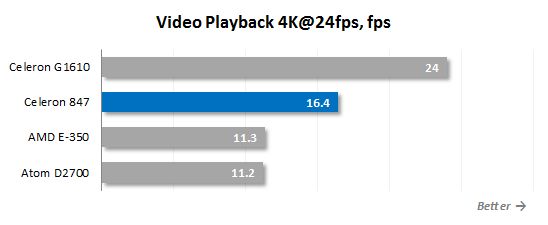
As you can see in the diagram, none of the economical processors can decode 4K video properly as the Celeron G1610 does. We always have some dropped frames: more on the Intel Atom D2700 and AMD E-350 and less on the Celeron 847 (about 30% of the total) but there are dropped frames anyway. In other words, it is impossible to build an uncompromising media player out of an inexpensive energy-efficient platform. You need heavier weapons for that. On the other hand, if you are not getting ready for UHD formats but prefer conventional Full-HD resolutions, the AMD E-350 and the Celeron 847 can be recommended for a compact and economical HTPC.
As for 3D performance, the platforms we’re discussing in this review can hardly be recommended even as entry-level gaming systems. Their 3D performance is too low, so you can only run games with low system requirements on them. There are fundamental differences between the integrated graphics cores, by the way. The Radeon HD 6310 core in the AMD E-350 is the most advanced variant in terms of specifications. It is the only one to support DirectX 11. The Celeron 847’s Intel HD Graphics only supports DirectX 10 (while the HD Graphics core of Intel’s LGA1155 Celeron processors has full DirectX 11 support). The Atom series is only compatible with DirectX 9.
The actual performance is illustrated by the results of the DirectX benchmark 3DMark Cloud Gate.
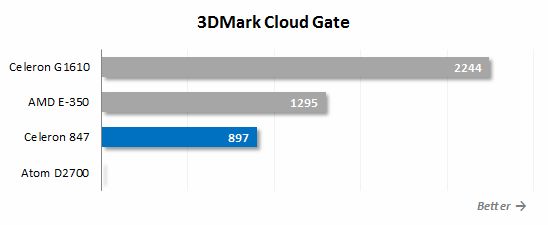
The Atom D2700 can’t pass this test for some reason whereas the Intel Celeron 847 is expectedly slower than the AMD E-350. The HD Graphics from the Celeron 847 is the fastest integrated graphics core among the economical processors but it is only half as fast as its newer version.
A low performance of the integrated graphics core is not the only reason why inexpensive economical platforms can’t be used for gaming computers. They often lack sheer computing speed. We can illustrate this fact by running a few games which don’t have high system requirements. Take note that they run at a low resolution (1366×768 pixels) and at the lowest visual quality settings.
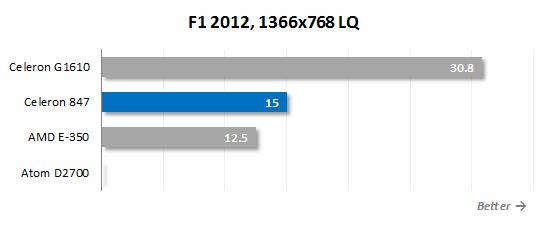
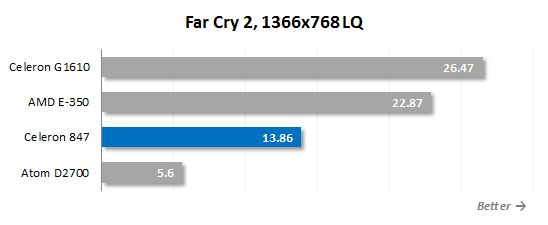
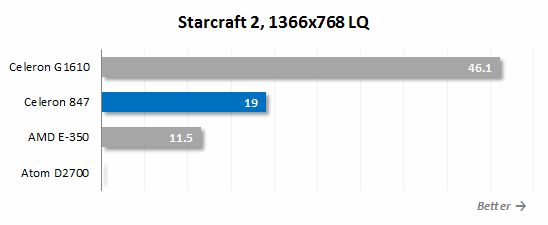
Even with such relaxed settings we can’t make our economical platform deliver good performance. As expected, the frame rate is often limited by the CPU, which is true for the E-350 at least, especially in Starcraft 2 and F1 2012. The Celeron 847 is superior to the AMD processor in these games, although the latter’s Radeon HD 6310 shouldn’t be any worse than the first-generation Intel HD Graphics.
Power Consumption
AMD’s E series and Intel’s Atom processors were originally developed for economical computers, so low power consumption is one of their key features. A Celeron, especially based on a 32nm Sandy Bridge core, doesn’t seem fit for energy-efficient computing, but the Celeron 847 has a specified TDP of 17 watts, which is comparable to AMD’s processors with Bobcat architecture. Is it really so? Can a slowed-down Sandy Bridge really ensure high performance while being comparable to specialized products optimized for low power consumption?
In order to answer all these questions we performed some power consumption tests. We used a new digital Corsair AX760i PSU that allows measuring the full consumption of each system (without the monitor) as measured at the PSU’s output. It is the sum total of the power draw of each system component. The PSU’s efficiency is not counted in. The CPU was running a 32-bit version of the LinX 0.6.4 utility. We used FurMark 1.10.4 utility to load the graphics cores.
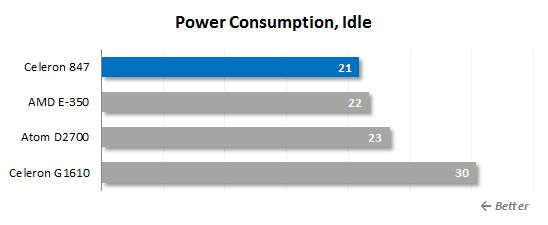
Without any work to do, every modern CPU switches to a special power-saving state in which it consumes just a few watts. In this case, the other system components and the efficiency of the mainboard’s voltage regulator mask the CPU’s consumption, which must be why the Celeron 847 based platform turns out to be the most economical when idle. It doesn’t differ much from the systems with Atom D2700 and E-350, though. The LGA1155 mainboard with Celeron G1610 needs much more power because mini-ITX LGA1155 products feature a versatile voltage regulator which supports different CPUs and even allows to overclock them. Its efficiency is low at low loads, so the Celeron G1610 based configuration is inferior to the mainboards with simpler and more economical voltage regulators in this test.
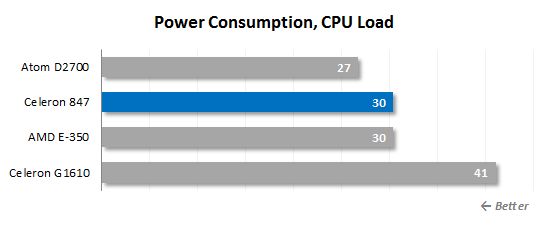
At full computing load the Celeron 847 based platform needs as much power as the AMD E-350 based one. The Atom platform is expectedly more economical because the Atom D2700 has a specified TDP of only 10 watts. The Celeron G1610 platform, which is not energy efficient at all, needs one third more power.
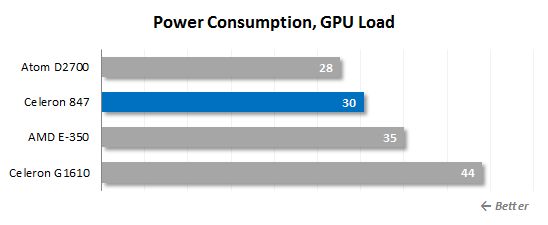
The Atom D2700 is the most economical again when it comes to gaming but its 3D speed is far from brilliant. The Celeron 847 is ahead among the CPUs with more or less acceptable 3D performance. It is almost as economical as the Atom D2700, unlike the AMD E-350.
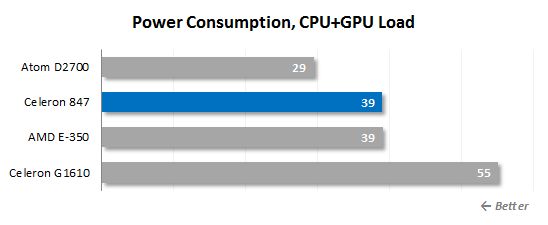
At high mixed load the Brazos and the Celeron 847 based platforms are again comparable in terms of power draw. So we can see that the Core microarchitecture really becomes economical if its voltage is reduced. Although it can’t match the Atom, it equals AMD’s Brazos-based solutions in this respect.
Conclusion
Intel’s economical, nettop-oriented variation of the old Sandy Bridge design looks very good, even though there is nothing new about the Celeron 847 which has been available earlier. But seeing the good sales of Brazos-based mini-ITX mainboards and the lackluster demand for Atom-based mini-ITX solutions, Intel has made the right decision to cut the price of junior mobile energy-efficient Celeron CPUs with Sandy Bridge design and retarget them at compact desktop systems where they have every chance to be a success, according to our tests.
Featuring Intel’s Celeron 847 processor and NM70 chipset, the mini-ITX mainboard we’ve tested is at least as good as its Brazos counterpart. Comparable to the latter in terms of heat dissipation, power consumption and price, it sports much higher performance – not only in computing tasks but also at HD video playback and even 3D gaming applications. As a result, Celeron 847-based configurations may be suitable for nettops as well as other classes of small form-factor PCs, including multimedia centers. Of course, the Celeron 847 is only half as fast as the slowest desktop Ivy Bridge CPU, yet its speed is high enough for most everyday applications we run on our home and office PCs.
The Celeron 847 + NM70 pair doesn’t put an end to Atom-based mainboards which remain unrivalled in terms of low power consumption and can still be used, for example, in home mini-servers. However, the Celeron 847, being a full-featured Core processor, is a better choice for compact and economical general-purpose computers.
As for the MSI C847IS-P33 mainboard we’ve used in this review, it is a well-made implementation of the Celeron 847 + NM70 platform. It is very inexpensive, which is its key advantage. Its functionality is rather limited due to the lack of additional controllers, but it has everything necessary anyway and looks attractive in terms of its functionality/price ratio.